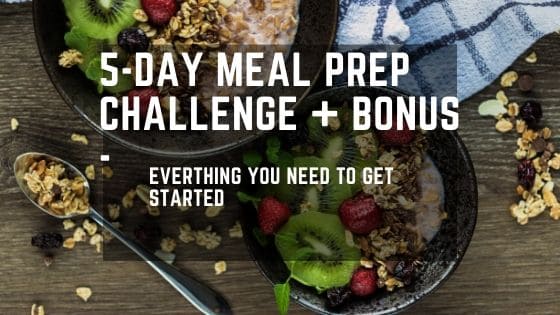Last Updated on February 26, 2024 by TheMealPrepNinja
Greetings! Welcome to my easy vegan meal prep guide for beginners. If you’re looking to incorporate more plant-based meals into your diet while saving time and money, you’ve come to the right place. In this comprehensive guide, I’ll walk you through the process of meal planning, prepping, and enjoying delicious vegan meals—all without breaking a sweat.
Plant-based meal planning can seem overwhelming at first, but I assure you it’s easier than you think. With some simple vegan recipes and a bit of preparation, you’ll have a week’s worth of nutritious meals ready in no time. Whether you’re a beginner in the kitchen or a seasoned chef, this guide will provide you with all the knowledge and inspiration you need to embark on your vegan meal prep journey.
Key Takeaways:
- Learn how to save time and money with easy vegan meal prep.
- Create a solid foundation for plant-based meal planning.
- Discover delicious and simple vegan recipes for your meal prep.
- Gain valuable tips for beginner meal prepping.
- Explore budget-friendly and healthy vegan meal prep options.
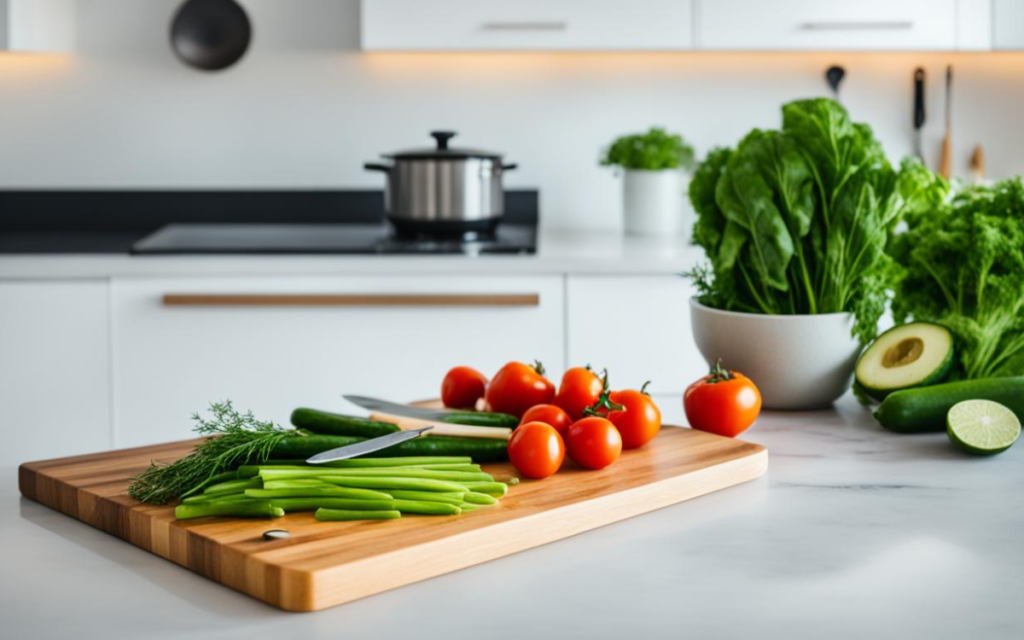
This post may contain affiliate links, which means we may receive a commission, at no extra cost to you, if you purchase through a link.
The Comprehensive Benefits of Vegan Meal Prep
When it comes to transitioning to a vegan lifestyle, meal prep is an essential tool for success. Not only does it simplify the process of planning and preparing meals, but it also offers a range of comprehensive benefits that can improve both your health and your lifestyle. In this section, we will explore the various advantages of vegan meal prep for beginners.
Health and Nutritional Advantages
One of the key benefits of vegan meal prep is its ability to promote better health and nutrition. By planning and preparing your meals in advance, you have greater control over the ingredients and portion sizes, ensuring that your meals are balanced and packed with the essential nutrients needed for optimal health.
Vegan meal prep allows you to incorporate a variety of fruits, vegetables, whole grains, and plant-based proteins into your diet, providing a wide range of vitamins, minerals, and antioxidants that support overall well-being.
Cost-Effective Grocery Shopping
Vegan meal prep is not only beneficial for your health but also for your wallet. By planning your meals in advance, you can create a detailed shopping list and avoid impulse purchases at the grocery store. This approach not only helps you stick to your budget but also minimizes food waste by only purchasing the ingredients you need. Additionally, buying ingredients in bulk for meal prep can often be more cost-effective than buying pre-packaged meals or dining out.
Time Management and Schedule Streamlining
For beginners, one of the biggest challenges of adopting a vegan lifestyle is finding the time to prepare meals from scratch. That’s where meal prep comes in. By devoting a dedicated block of time each week to preparing your meals in advance, you can save valuable time throughout the week. No more scrambling for last-minute meal ideas or spending hours in the kitchen every night.
Vegan meal prep allows you to streamline your schedule, make the most of your time, and ensure that you always have a nutritious meal ready to enjoy, no matter how busy you are.
| Vegan Meal Prep Benefits |
|---|
| Improved health and nutrition |
| Cost-effective grocery shopping |
| Time-saving meal prep for beginners |
Getting Started with Vegan Meal Prep for Beginners
Understanding Vegan Meal Prep Basics
Before diving into the world of vegan meal prep, it’s important to understand the basics. Vegan meal prep involves planning and prepping meals in advance, allowing you to have ready-to-eat or easy-to-assemble meals throughout the week. This approach not only saves time but also ensures you have nutritious and delicious meals on hand.
When starting with vegan meal prep, consider the number of meals you want to prep in advance. Some people prefer to prep lunches and dinners, while others may want to include breakfasts and snacks as well. Think about your preferences and schedule to create a plan that works best for you.
“Vegan meal prep involves planning and prepping meals in advance, allowing you to have ready-to-eat or easy-to-assemble meals throughout the week.”
Identifying Essential Vegan Ingredients
Stocking your kitchen with essential vegan ingredients is crucial for successful meal prep. Having these staple items readily available will make the process easier and more efficient. Here are some essential vegan ingredients to include in your meal prep arsenal:
- Grains and Legumes: Including items like rice, quinoa, lentils, and chickpeas provides a solid foundation for your meals.
- Fruits and Vegetables: Aim for a variety of colorful and nutrient-dense produce, such as leafy greens, berries, bell peppers, and sweet potatoes.
- Plant-Based Proteins: Incorporate tofu, tempeh, seitan, and beans to ensure you’re getting enough protein in your meals.
- Healthy Fats: Avocado, nuts, seeds, and olive oil are great sources of healthy fats that add flavor and richness to your dishes.
- Herbs and Spices: Enhance the taste of your meals with a wide range of herbs and spices, such as garlic, turmeric, cumin, and basil.
| Grains and Legumes | Fruits and Vegetables | Plant-Based Proteins | Healthy Fats | Herbs and Spices |
|---|---|---|---|---|
| Rice | Leafy Greens | Tofu | Avocado | Garlic |
| Quinoa | Berries | Tempeh | Nuts | Turmeric |
| Lentils | Bell Peppers | Seitan | Seeds | Cumin |
| Chickpeas | Sweet Potatoes | Beans | Olive Oil | Basil |
Developing Your Beginner Vegan Grocery List
Creating a well-stocked vegan grocery list is essential for successful meal prep. By having the right ingredients on hand, you’ll be able to whip up delicious and nutritious plant-based meals with ease. In this section, I’ll guide you through selecting the staples for a plant-based pantry, choosing vibrant and nutrient-packed fresh produce, and discovering plant-based protein sources to keep you feeling satisfied.
Staples for a Plant-Based Pantry
A well-stocked pantry is the foundation of every successful vegan meal prep. Here are some essential items to include on your beginner vegan grocery list:
- Whole grains like quinoa, brown rice, and oats
- Legumes such as lentils, chickpeas, and black beans
- Canned or dried fruits and vegetables for added flavor and versatility
- Plant-based milk alternatives like almond, soy, or oat milk
- Healthy fats like avocado, nuts, and seeds
- Herbs and spices to enhance the flavor of your meals
- Condiments and sauces such as tamari, tahini, and nutritional yeast
Having these pantry staples readily available will ensure that you have a variety of ingredients to work with when meal prepping.
Fresh Produce: Selecting a Rainbow of Nutrients
When selecting fresh produce for your vegan meal prep, it’s important to incorporate a variety of fruits and vegetables to ensure you’re getting a wide range of nutrients. Aim to include a colorful assortment of the following:
- Leafy greens like spinach, kale, and arugula
- Cruciferous vegetables such as broccoli, cauliflower, and Brussels sprouts
- Brightly colored fruits like berries, oranges, and watermelon
- Root vegetables including carrots, sweet potatoes, and beets
- Fresh herbs like cilantro, basil, and mint
Adding a variety of fresh produce to your meals will not only make them visually appealing but also provide an abundance of essential vitamins, minerals, and antioxidants.
Proteins: Plant-Based Sources to Keep You Sated
Protein is an important component of any well-rounded meal, and a plant-based diet can provide all the protein you need. When building your beginner vegan grocery list, consider including these plant-based protein sources:
- Legumes such as lentils, chickpeas, and black beans
- Tofu, tempeh, and other soy-based products
- Quinoa, amaranth, and other whole grains
- Nuts and seeds like almonds, walnuts, chia seeds, and hemp seeds
- Plant-based protein powders for smoothies and shakes
By incorporating these protein-rich foods into your diet, you’ll have the necessary fuel to power you through your day and keep you feeling satisfied.
With these tips and suggestions, you’re well on your way to developing a beginner vegan grocery list that will set you up for successful meal prepping. Now, let’s move on to the next section and delve into the creation of easy vegan meal plans.
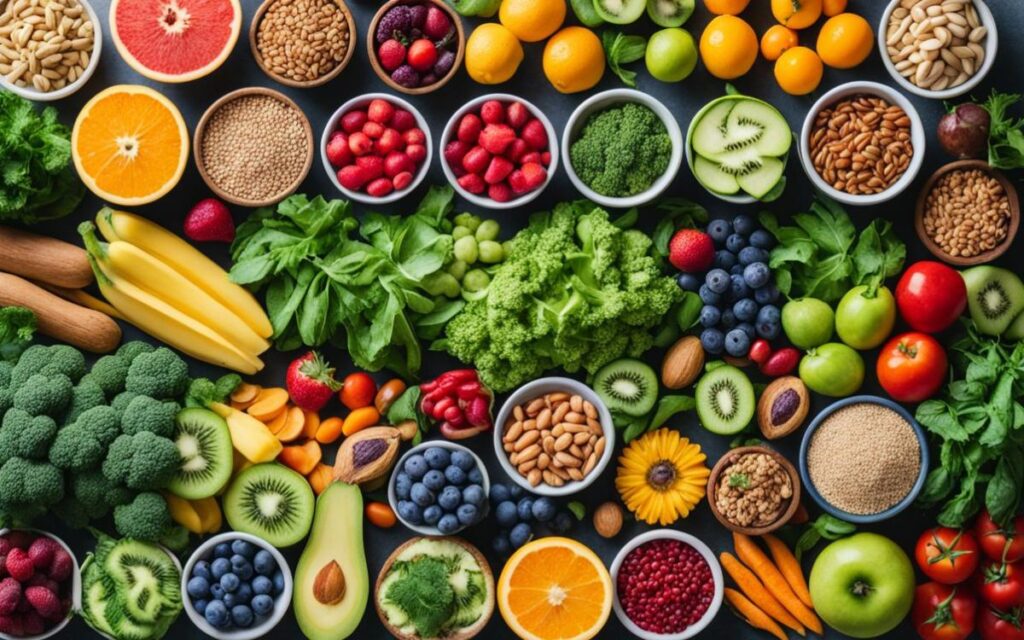
Creating Easy Vegan Meal Plans
Structuring your plant-based week and incorporating diverse and nutritious recipes are key components of creating easy vegan meal plans. Meal planning is crucial for those transitioning to a vegan lifestyle, as it helps ensure that you have balanced and satisfying meals throughout the week.
By incorporating a variety of recipes, you can explore different flavors and textures while also obtaining a wide range of nutrients.
Structuring Your Plant-Based Week
When creating a meal plan, it’s important to consider the overall structure of your week. This involves thinking about your schedule, dietary preferences, and specific nutritional needs. Here are some tips for structuring your plant-based week:
- Plan for a balanced distribution of meals throughout the week, including breakfast, lunch, dinner, and snacks.
- Consider incorporating theme nights, such as Mexican Mondays or Stir-Fry Fridays, to add variety and excitement to your meals.
- Take into account any social events or commitments that might impact your meal plan, and make adaptations accordingly.
- Include a mix of simple and more elaborate recipes to match your energy levels and time availability on different days.
Incorporating Diverse and Nutritious Recipes
When creating easy vegan meal plans, it’s important to include a diverse range of recipes to ensure you’re getting a wide range of nutrients. Here are some tips for incorporating diverse and nutritious recipes:
- Explore different cuisines, such as Mediterranean, Asian, or South American, to introduce new flavors and ingredients.
- Include recipes that feature a variety of whole grains, legumes, fruits, vegetables, and plant-based proteins.
- Experiment with different cooking methods, such as roasting, steaming, or grilling, to add variety to your meals.
- Incorporate different colors on your plate to ensure a good mix of vitamins, minerals, and antioxidants.
- Don’t be afraid to try new ingredients and flavors to keep your meals interesting and enjoyable.
Creating easy vegan meal plans is all about finding a balance between structure and flexibility. While it’s important to have a plan in place, it’s also important to be open to making changes and adjustments based on your preferences and needs.
| Benefits of Structured Meal Plans | Tips for Meal Planning |
|---|---|
| 1. Ensures a balanced and nutritious diet. | 1. Set aside dedicated time each week for meal planning and grocery shopping. |
| 2. Helps save time and reduce stress during meal times. | 2. Keep a well-stocked pantry with essential vegan ingredients for easy meal preparation. |
| 3. Promotes portion control and prevents overeating. | 3. Take advantage of leftovers by incorporating them into the following day’s meals. |
| 4. Reduces food waste by utilizing ingredients efficiently. | 4. Stay flexible and be open to making adjustments to your meal plan as needed. |
Vegan Meal Prep for Beginners: A Step-by-Step Approach
When it comes to successfully incorporating vegan meal prep into your routine, a step-by-step approach is key. By following a systematic process, you can ensure efficient and effective meal prepping that saves you time and effort.
In this section, I will guide you through the essential steps of vegan meal prep for beginners, from choosing suitable recipes to employing preparation techniques for maximum efficiency.
Choosing Recipes Suitable for Meal Prepping
Before diving into meal prep, it’s crucial to select recipes that lend themselves well to prepping in advance. Look for recipes that:
- Require minimal last-minute preparation
- Can be easily stored and reheated without compromising taste or texture
- Incorporate ingredients that stay fresh and maintain their quality over time
By choosing recipes that meet these criteria, you can streamline your meal prep process and ensure that your meals are delicious and convenient throughout the week.
Preparation Techniques for Efficiency
Efficient meal preparation techniques can significantly enhance your vegan meal prep experience. Here are some tips to optimize your prep process:
1. Plan and organize:
Create a meal plan for the week and make a comprehensive grocery list. Organize your ingredients and kitchen tools beforehand, so everything is accessible when you start prepping.
2. Batch cooking:
Batch cooking involves making larger quantities of food at once to enjoy throughout the week. This technique saves time and ensures that you always have ready-to-eat meals on hand.
3. Use time-saving appliances:
Invest in time-saving kitchen appliances, such as a slow cooker, pressure cooker, or food processor. These tools can expedite the cooking process and allow you to multitask while preparing your meals.
4. Pre-cut and pre-portion ingredients:
Pre-cutting vegetables, portioning out ingredients, and prepping sauces or dressings in advance can significantly reduce your prep time and make assembling meals quicker and more convenient.
By implementing these techniques, you can optimize your meal prep process and make it a seamless and enjoyable part of your weekly routine.
Now that you have a step-by-step understanding of vegan meal prep for beginners, you are equipped with the knowledge and strategies to embark on your meal prep journey. In the next section, I will share a collection of easy vegan recipes and cooking tips to inspire and support your meal prep efforts.
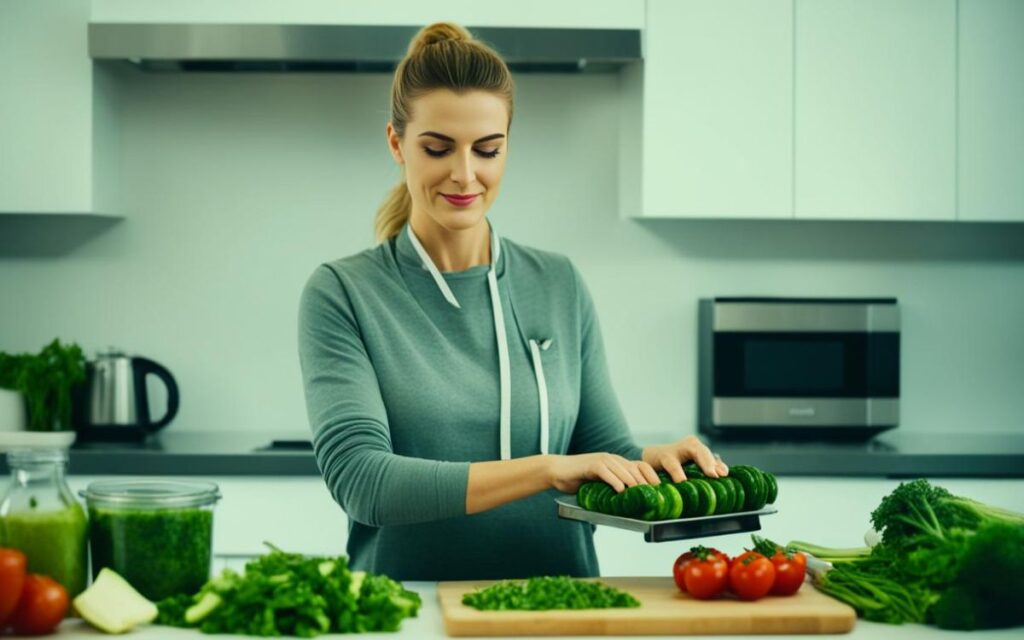
Easy Vegan Recipes and Cooking Tips
In this section, I will share a collection of easy vegan recipes that are perfect for meal prep. These recipes are not only delicious but also require minimal effort and time in the kitchen. Whether you’re a beginner or an experienced cook, these recipes will help you create flavorful plant-based meals that you can enjoy throughout the week.
Quinoa and Black Bean Salad
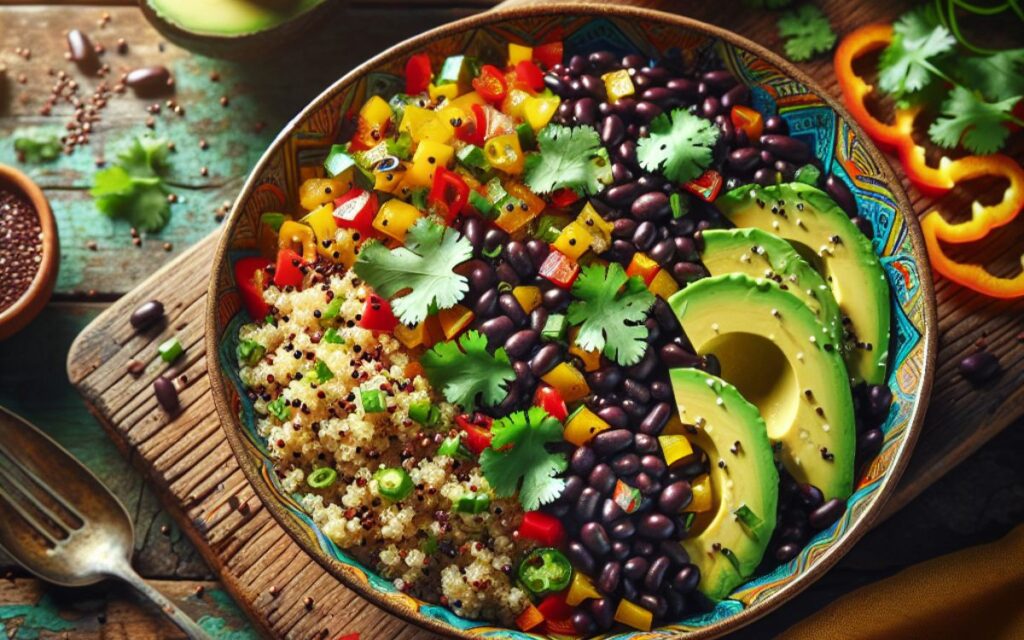
Ingredients:
- 1 cup quinoa
- 2 cups water
- 1 can (15 ounces) black beans, drained and rinsed
- 1 red bell pepper, diced
- 1/4 cup fresh cilantro, chopped
- 1/4 cup lime juice
- 2 tablespoons olive oil
- 1 teaspoon ground cumin
- Salt and pepper to taste
- 1 avocado, diced (optional)
Instructions:
- Cook Quinoa: In a medium saucepan, bring the quinoa and water to a boil. Reduce heat to low, cover, and simmer for about 15 minutes, or until quinoa is cooked and water is absorbed. Fluff with a fork and let it cool.
- Prepare Salad: In a large bowl, combine the cooled quinoa, black beans, red bell pepper, and cilantro.
- Make Dressing: In a small bowl, whisk together lime juice, olive oil, ground cumin, salt, and pepper.
- Combine: Pour the dressing over the quinoa mixture and stir until well combined. Gently fold in the diced avocado if using.
- Chill: Refrigerate for at least an hour before serving to allow flavors to meld.
Vegan Stir-Fry with Tofu and Broccoli
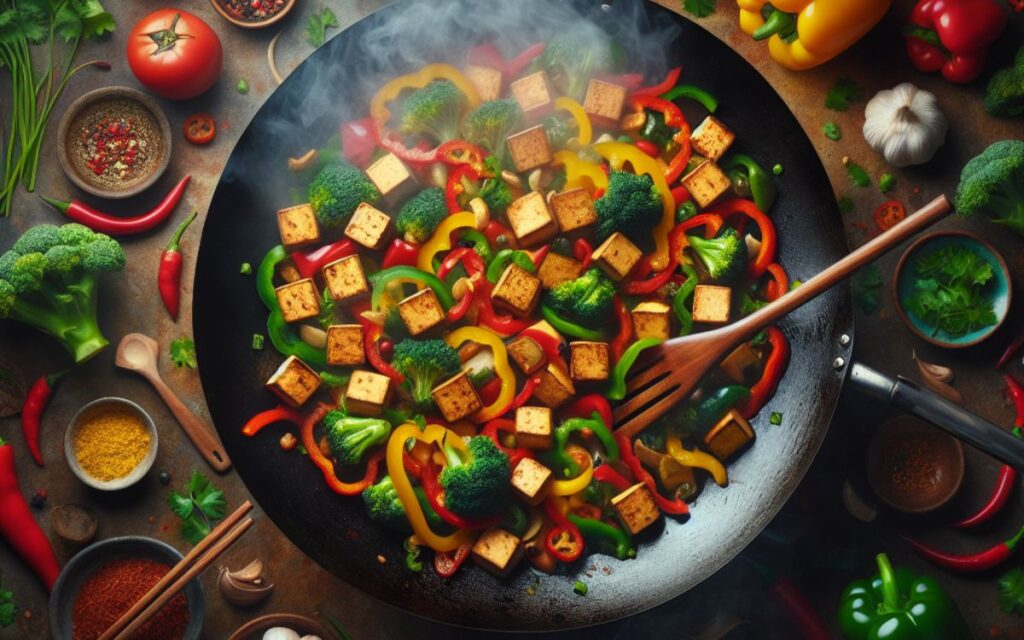
Ingredients:
- 1 block (14 ounces) firm tofu, pressed and cut into cubes
- 2 tablespoons soy sauce
- 1 tablespoon maple syrup
- 1 tablespoon olive oil
- 2 cups broccoli florets
- 1 red bell pepper, sliced
- 2 cloves garlic, minced
- 1 tablespoon fresh ginger, minced
- 2 tablespoons water
- 1 tablespoon cornstarch
- 2 tablespoons sesame oil
- Salt and pepper to taste
- Cooked rice, for serving
Instructions:
- Marinate Tofu: In a bowl, combine the tofu cubes with soy sauce and maple syrup. Let it marinate for at least 15 minutes.
- Cook Tofu: Heat olive oil in a large pan over medium heat. Add the marinated tofu cubes and cook until browned on all sides. Remove tofu from the pan and set aside.
- Stir-Fry Vegetables: In the same pan, add a little more oil if needed. Add broccoli, red bell pepper, garlic, and ginger. Stir-fry for about 5-7 minutes, or until vegetables are just tender.
- Thicken Sauce: In a small bowl, mix water and cornstarch. Add this mixture to the pan along with the sesame oil. Cook until the sauce thickens.
- Combine: Return the cooked tofu to the pan. Stir everything together and cook for an additional 2 minutes. Season with salt and pepper to taste.
- Serve: Serve the stir-fry over cooked rice.
These recipes are not only simple and delicious but also highly nutritious, providing a balance of protein, fiber, and healthy fats. Enjoy your meal prep!
Batch Cooking and One-Pot Wonders
One of the key strategies for efficient vegan meal prep is batch cooking. This technique involves preparing a large quantity of food at once, which can be portioned out and stored for future meals. Batch cooking not only saves time but also allows you to have ready-made meals on hand when you need them.
Try making a big batch of vegan chili or vegetable curry that you can portion out into individual servings. These hearty recipes are not only easy to prepare but also freeze well, making them ideal for meal prep. You can also experiment with one-pot wonders like stir-fries, pasta dishes, or grain bowls that require minimal cleanup and can be easily customized with your favorite ingredients.
Another great tip for efficient meal prep is to choose recipes that use similar ingredients. This way, you can maximize your grocery shopping and minimize food waste. For example, if you’re making a roasted vegetable salad, you can reserve some of the roasted vegetables to use in a wrap or grain bowl later in the week.
Utilizing Vegan Meal Prep Containers Efficiently
When it comes to meal prep, using the right containers is essential for keeping your food fresh and organized. Invest in a set of good-quality meal prep containers that are durable, leak-proof, and stackable.
For easy portion control, choose containers that have compartments to separate different components of your meal, such as grains, proteins, and vegetables. This way, you can easily grab a container and enjoy a balanced meal without any need for additional prep.
When storing your prepared meals, make sure to label them with the date and contents, so you can easily identify them later. This will help you keep track of what you have on hand and ensure that nothing goes to waste. Additionally, consider using reusable silicone bags or glass containers for snacks or smaller portions that can be easily packed for on-the-go meals or snacks.
Overall, efficient use of meal prep containers will help you stay organized, save time, and make your meal prep experience much more convenient.
Storing and Reheating Your Vegan Meals
Properly storing and reheating your vegan meals is essential for maintaining their freshness, flavor, and safety. By following food safety practices and employing freezer-friendly options, you can ensure that your meal prepped dishes remain delicious and enjoyable even after being stored.
Emphasizing Food Safety and Flavor Preservation
When storing your vegan meals, it’s crucial to consider food safety guidelines to prevent bacterial growth and maintain the quality of your food. Here are some tips to keep in mind:
- Store cooked vegan meals in airtight containers to prevent contamination and preserve flavors.
- Refrigerate your meals within two hours of cooking to inhibit the growth of harmful bacteria.
- Label and date your containers to easily track the freshness of your meals and prioritize consumption accordingly.
- Keep your refrigerator temperature at or below 40°F (4°C) to ensure optimal food preservation.
When reheating your vegan meals, it’s important to do so safely while preserving their flavors and textures. Consider the following tips:
- Reheat your meals thoroughly to a temperature of at least 165°F (74°C) to eliminate any potential bacteria.
- Avoid overcooking by using gentle reheating methods, such as microwaving on lower power levels or using a steamer.
- When using a microwave, stir your meal periodically to ensure even reheating and prevent hot spots.
- For meals with delicate components, such as salads or dressings, consider adding them separately after reheating to maintain their freshness.
Freezer-Friendly Options for Longer Shelf Life
If you’re looking to extend the shelf life of your vegan meal preps, freezer-friendly options are a valuable solution. Freezing can help preserve the taste, texture, and nutritional value of your meals. Here are some guidelines to follow:
- Choose freezer-safe containers or resealable freezer bags to prevent freezer burn and maintain quality.
- Ensure your meals are cooled completely before freezing to prevent condensation and ice crystal formation.
- Label your frozen meals with the name and date of preparation to easily track their freshness.
- For best results, consume your frozen meals within three months.
| Freezer-Friendly Vegan Meal Ideas | Shelf Life |
|---|---|
| Vegan Chili | Up to 3 months |
| Roasted Vegetable Medley | Up to 3 months |
| Vegetable Curry | Up to 3 months |
| Quinoa Stuffed Bell Peppers | Up to 3 months |
| Vegan Meatballs | Up to 3 months |
Freezing your vegan meals not only extends their shelf life but also offers convenience for busy days or when you’re short on time. By employing freezer-friendly options, you can always have a delicious and nutritious meal ready to enjoy.
Adapting Meal Prep to Your Lifestyle
When it comes to vegan meal prep, it’s essential to adapt the process to fit your specific lifestyle. Whether you have dietary restrictions, food allergies, or specific preferences, there are ways to customize your meal prep routine to meet your unique needs.
Adjusting for Dietary Restrictions and Allergies
If you have dietary restrictions or food allergies, it’s important to consider these factors when planning your vegan meal prep. By understanding your specific requirements, you can make informed choices about the ingredients you use and ensure that your meals are safe and enjoyable.
To accommodate dietary restrictions, such as gluten intolerance or soy sensitivity, you can explore alternative ingredients and substitutes that meet your needs. For example, instead of using soy sauce, opt for tamari or coconut aminos as a gluten-free alternative. Similarly, you can use gluten-free flours in your baked goods or choose nut-based cheeses instead of dairy-based options.
For those with food allergies, be diligent in reading ingredient labels and selecting allergen-free options. You can also adapt recipes by substituting allergenic ingredients with suitable alternatives. By being mindful of your dietary restrictions and allergies, you can create meal preps that are safe, healthy, and align with your nutritional needs.
Suggestions for Singles, Couples, and Families
Meal prep can be tailored to various household sizes and dynamics, whether you’re cooking for yourself, as a couple, or for a whole family. Here are some suggestions to adapt your meal prep routine accordingly:
Meal Prep for Singles:
- Choose recipes that can be easily scaled down to single portions.
- Consider prepping individual meals that can be mixed and matched for variety throughout the week.
- Invest in portion-sized meal prep containers for convenient storage and reheating.
Meal Prep for Couples:
- Select recipes that serve two portions, allowing for easy meal sharing.
- Opt for meal components that can be customized individually to cater to personal preferences.
- Coordinate meal prep tasks with your partner to divide and conquer the cooking process.
Meal Prep for Families:
- Plan meals that accommodate the tastes and dietary needs of all family members.
- Consider batch cooking larger quantities and freezing individual portions for future meals.
- Involve the whole family in meal prep activities, making it a fun and collaborative experience.
By adapting meal prep to your household size, you can streamline your cooking process and ensure everyone’s nutritional needs are met.
Adapting meal prep to fit your lifestyle, dietary restrictions, and household needs allows you to make the most of this time-saving and health-conscious approach to eating. By customizing your meal prep routine, you can enjoy delicious, nutritious, and convenient meals that align with your individual preferences.
Conclusion
As we come to the end of this beginner’s guide to vegan meal prep, I encourage you to embrace the journey ahead. Incorporating meal prep into your lifestyle can bring a multitude of benefits and rewards.
By taking the time to plan and prepare meals in advance, you can save time and energy throughout the week, while also nourishing your body with delicious and nutritious plant-based meals.
Throughout this guide, I have highlighted the numerous advantages of vegan meal prep. From the health and nutritional benefits to the cost-effectiveness and time-saving aspects, meal prep is a game-changer for beginners looking to adopt a vegan lifestyle.
By having a well-stocked pantry, utilizing fresh produce, and exploring diverse recipes, you can ensure that your vegan meal prep is both enjoyable and nutrient-rich.
Along the way, you may encounter common challenges with meal prep, but don’t let them discourage you. With a little troubleshooting, you can overcome these hurdles and continue on your meal prep journey. Whether it’s finding the right recipes that suit your taste preferences, optimizing your meal preparation techniques for efficiency, or adjusting portion sizes for your specific needs, there are solutions to every challenge. Here is my meal prep for beginners ultimate guide for more resources.
FAQ
What are the benefits of vegan meal prep for beginners?
Vegan meal prep offers several benefits, including saving time and money, improving health and nutrition, and streamlining schedules. By planning and prepping meals in advance, beginners can enjoy balanced and nutritious meals, cut down on food waste, and have more time for other activities.
How can vegan meal prep contribute to improved health and nutrition?
Vegan meal prep promotes balanced and nutritious meals by allowing beginners to plan and choose ingredients wisely. By incorporating a variety of plant-based foods, such as fruits, vegetables, whole grains, legumes, and nuts, beginners can ensure they receive a wide range of essential nutrients and promote their overall health and well-being.
How can vegan meal prep save me money?
Vegan meal prep can save money by helping beginners make cost-effective grocery shopping choices. By planning meals in advance and buying ingredients in bulk, beginners can take advantage of sales and discounts. Additionally, meal prepping reduces the likelihood of impulse purchases and minimizes food waste, further contributing to cost savings.
Can vegan meal prep help me save time?
Yes, vegan meal prep can save time by reducing the amount of time spent cooking each day. By prepping meals in advance, beginners can cut down on cooking and preparation time throughout the week. This allows for more free time to engage in other activities or relax.
How do I get started with vegan meal prep for beginners?
To get started with vegan meal prep, begin by understanding the basics of meal prepping, such as planning and prepping meals in advance. It is also essential to stock your kitchen with essential vegan ingredients, such as spices, grains, legumes, and plant-based proteins, to make meal prepping easier and more enjoyable.
What are essential vegan ingredients for meal prep?
Essential vegan ingredients for meal prep include a variety of grains (such as quinoa, brown rice, and oats), legumes (such as chickpeas, lentils, and black beans), nuts and seeds, plant-based proteins (such as tofu, tempeh, and seitan), a variety of fruits and vegetables, and spices and seasonings.
How can I develop a vegan grocery list for meal prep?
To develop a vegan grocery list for meal prep, start by stocking up on pantry staples such as grains, legumes, nuts, and seeds. Additionally, pick a variety of fresh produce to incorporate into your meal prep for maximum nutrition. Don’t forget to include plant-based protein sources to ensure satiety and well-rounded meals.
How do I create easy vegan meal plans for beginners?
To create easy vegan meal plans, start by structuring your plant-based week, ensuring meals are diverse and nutritious. Plan out your recipes ahead of time and make a shopping list based on the ingredients needed. Aim for a variety of flavors, textures, and nutrients to keep your meals exciting and enjoyable.
How do I choose recipes suitable for vegan meal prep?
When choosing recipes for vegan meal prep, look for recipes that are easily scalable and can be stored for a few days without compromising flavor or texture. Select recipes that use staple ingredients and can be prepared in advance, such as soups, stews, casseroles, and stir-fries.
What are some easy vegan recipes suitable for meal prep?
Some easy vegan recipes that are suitable for meal prep include quinoa and black bean salad, chickpea curry, roasted vegetable Buddha bowls, lentil and vegetable stir-fry, and sweet potato and black bean enchiladas. These recipes can be prepared in advance and stored without losing their taste and texture.
How do I properly store and reheat vegan meals prepared in advance?
To store and reheat vegan meals prepared in advance, make sure to use airtight containers and refrigerate them promptly. When reheating, use appropriate methods such as stovetop reheating or microwaving. Be mindful of food safety and ensure that meals are heated to the appropriate temperature before consumption.
How can I adapt vegan meal prep to my specific lifestyle needs?
You can adapt vegan meal prep to your specific lifestyle needs by adjusting it for dietary restrictions and food allergies. Make substitutions as needed and explore alternative ingredients that fit your dietary needs. Additionally, consider portion sizes and different dietary preferences when meal prepping for singles, couples, or families. Here is an article on Keto meal prep for beginners.
Why should beginners embrace the vegan meal prep journey?
Beginners should embrace the vegan meal prep journey because it offers numerous benefits, including improved health and nutrition, cost savings, time management, and reduced food waste. By investing time and effort into meal prep, beginners can experience the rewards of enjoying delicious, nutritious meals while simplifying their lives.
What challenges might beginners face with vegan meal prep, and how can they troubleshoot them?
Beginners may face challenges such as time constraints, lack of variety, or difficulty in sticking to the plan. To troubleshoot these challenges, beginners can start with simple recipes, involve family members or friends in the meal prep process, and experiment with new ingredients and flavors to keep the meals exciting and enjoyable.

Jim Lopez, the founder and editor of The Meal Prep Ninja, shares his journey from a passionate bodybuilder and fitness enthusiast to a certified nutrition coach. Certified by Precision Nutrition, Jim aims to empower others with knowledge on meal prep and nutrition, offering resources for busy individuals to enjoy low-calorie, tasty foods. His blog is a community for sharing healthy eating habits and meal prep recipes
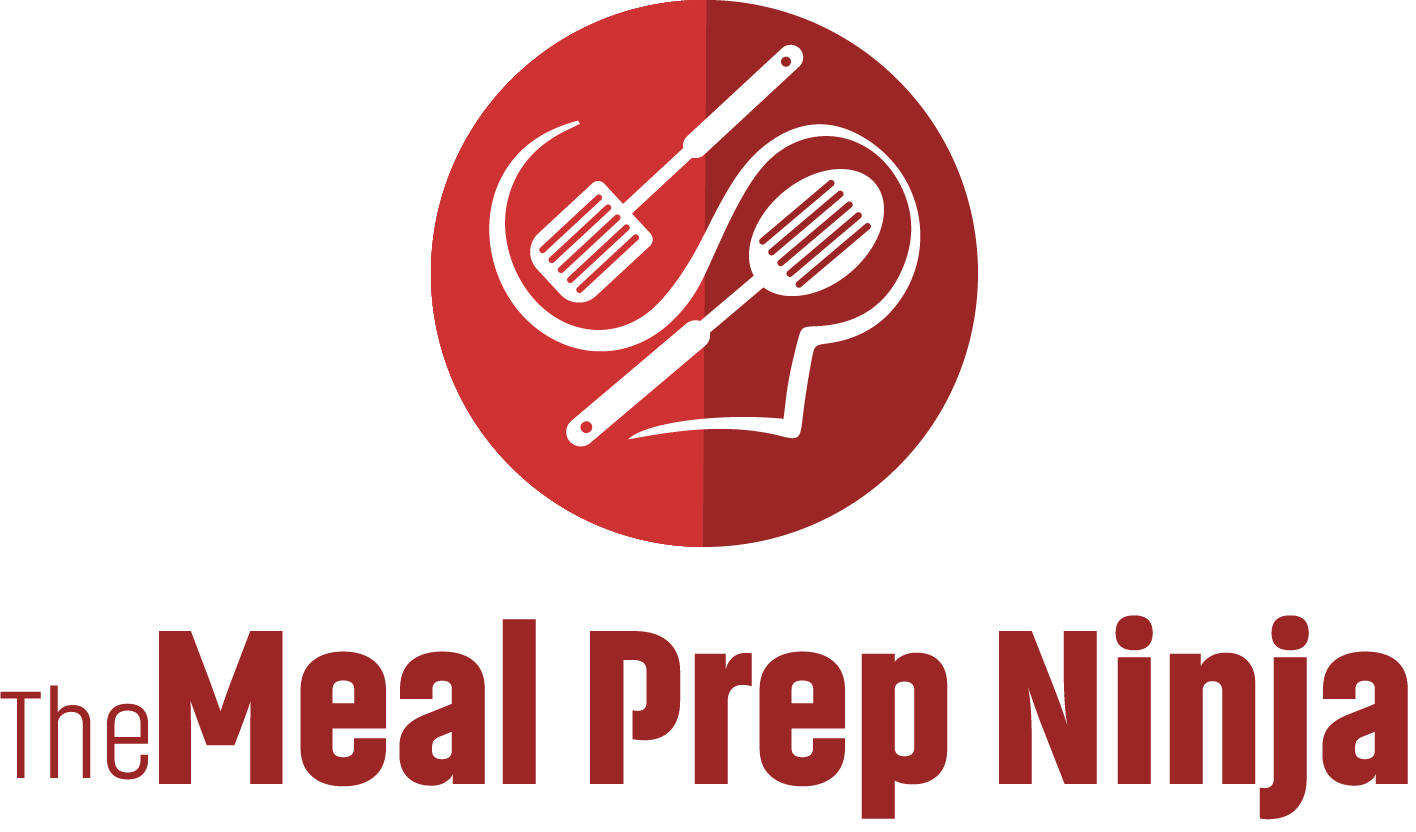
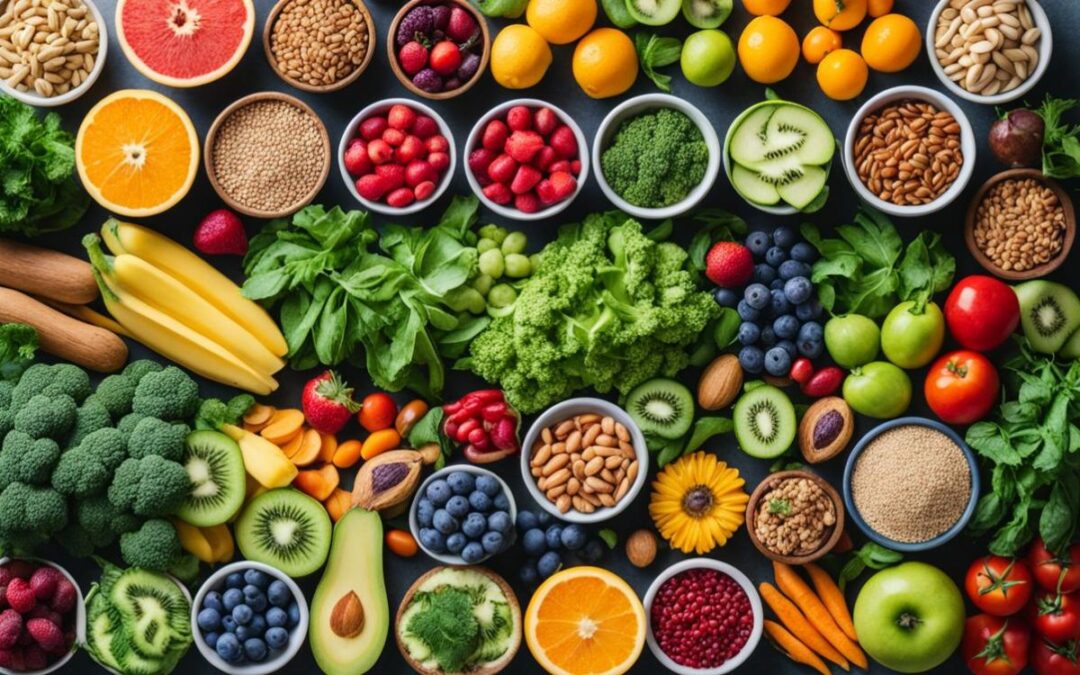


![Freshware Meal Prep Bowl Containers [30 Pack] Plastic Bowls with Lids for Soup and Salad, Food Storage Bento Box, BPA Free, Stackable, Lunch Boxes, Microwave/Dishwasher/Freezer Safe (28 oz)](https://m.media-amazon.com/images/I/51TLCZLYY3L._SL160_.jpg)

